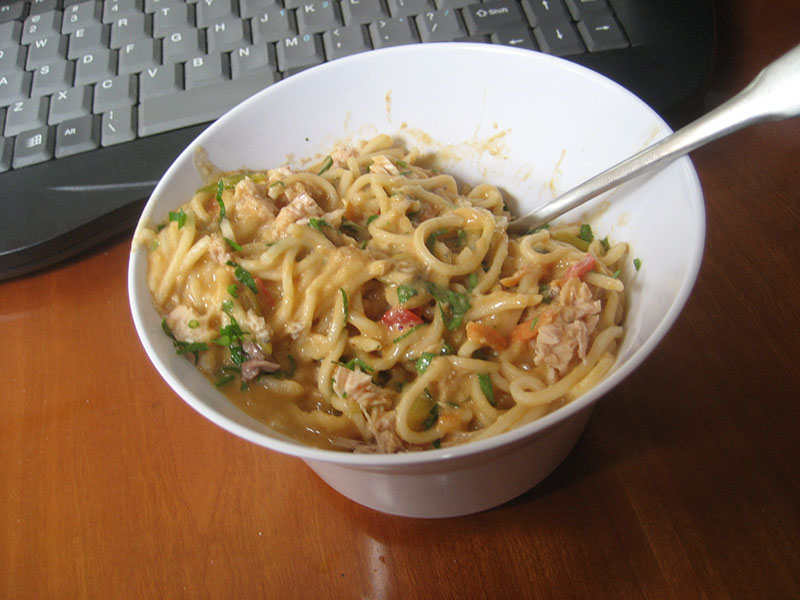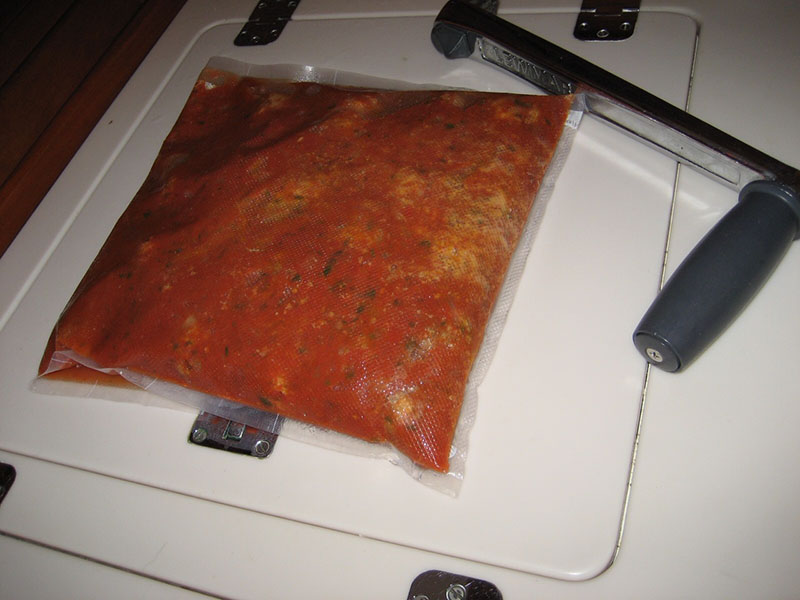To put together a well thought out meal program for a race of this size is a good investment of time and resources. For us it was a 3 month process of planning, sourcing, cooking, shopping and stowing.
We’ve provisioned the boat for a lot of shorter 4-5 day ocean races always with the philosophy of “a well fed crew sails faster.” A TransAtlantic Race poses the ultimate logistical and tetris challenge: feed 7 people for 21 days (a total of 441 meals) without a trip to the grocery store – don’t forget, you have a limited water supply and need to fit everything into whatever spare nooks and crannies you can find on a 42’ boat. No problem, right?
We wanted a good variety of dishes that were tasty and nutritious. After working through multiple options, we decided on a 6-day meal rotation that was equal parts prepared meals, “par-prepared” and freeze dried dishes. The main meal would be served mid-day (Navy-style) when most of the crew was awake.
The prepared meals, or casseroles, such as lasagna and chicken cutlets over a bed of peas and rice were easy – we would thaw them out in the oven overnight, heat them up and ready to go.

Par-prepared meals consisted of prepared sauces vacuum sealed and frozen into flat “bricks” to be combined with dried goods from the “pantry” such as pasta or rice. Parsing out only what needed to be refrigerated saved us a lot of space. For our Dirty Rice the sauce was frozen into a flat brick and everything else was “dry or shelf stable” including Chinese sausage and a premixed bag of rice, quick cooking adzuki beans and spices.

For our freeze dried meals we researched just about every brand available and then ordered or purchased samples from the top recommendations. It is surprising the spectrum that is available starting with something akin to reconstituted cardboard. Using my ski house friends as taste testers, I sussed out what I thoughts was the best quality and most akin to real food – for us that was Cache Creek. During testing, I was also able to determine whether each dish could be improved by doctoring it up with addition of other ingredients.

To limit the amount of galley equipment, meal preparation was focused on using only a pressure cooker. For example, for spaghetti and meatballs the pasta was cooked first in the pressure cooker and then the thawed vacuum sealed sauce bag was laid on top for 5 min to heat through. Using only one pot cut down on cleanup and the faster cooking times reduced our propane needs. More importantly, pressure cookers have a built in locking system adding safety to cooking in high seas. Should you hit a rogue wave launching the pot from the stove its contents would be contained instead of creating a massive mess or, worse, burning a crew member.
Now it was time to turn our attention to snacks and midrats – equally important for a 24/7 operation of an ocean race. We reserve one cabinet in the galley for a wide variety of grab and go items. Top of the list is always GORP (a pre-batched combination of peanuts, M7Ms and raisins) and an assortment of sweet and savory items. Included are the simplest staples – peanut butter and jelly and saltines which can nourish an unsettled stomach in the worst of foul weather. Each type of snack was stored in it’s own Ziploc bag heling keep the cabinet tidy and making it easy to pass up around the cockpit. I’ve learned that crew are more likely to eat or drink on a watch and stay hydrated if something is right in front of them. So we keep water bottles in the cockpit and I’m constantly passing up bags of treats or bowls of cut fruit. And they always come back empty with selection of different granola and energy bars, lots of fruit stored in a mesh hanging basket, pretzel rods, pringles, dried fruit, jerky, and a variety of candy (such as twizlers, sour patch kids and jolly ranchers.
For the night watches we had individual cup of soup packets and would leave a thermos of hot water in the galley.
- The Snack/ MidRats Cabinet
- GORP
- Fruit
- Assortment of granola and energy bars
- Pretzel rods, Pringles (can for freshness and storage), jerky
- Assorted candy (Jolly Ranchers, mini, packaged chocolate bars)=, Sour Patch, Twizlers)
- Peanut butter & jelly
- Saltines
- Individual Cup O’ Soup packets (hot water thermos)
In addition I scurried away “special” sweet and savory “treats” for a surprise factor. Every day or two the crew would be treated to something new and different: watermelon, pre-scooped frozen cookie dough to bake off, pickles, flavored popcorn, smoked oysters, hummus, freeze dried pudding or a pint of Ben & Jerry’s ice cream. We also sourced blocks of aged, hard cheeses and dried salumi that would hold well without refrigeration. Sliced up they served as a great afternoon snack bowl.
Once the planning is done, the meals prepared and provisions purchased there is till the ultimate tetris challenge of fitting everything, securely on the boat.

The freezer on JIV is only about 6 cubic feet and we produced 85 pounds of prepared food. To most effectively utilize the space everything was packaged in either vaccum sealed bags or disposable pans with the same size foot print and frozen as flat as possible. This created “bricks” that could neatly be stacked and minimizing negative space.

Here is a photo of all of our freezer items before being packed onto the boat. Note how everything is the same size and stacks neatly. Meals were loaded into the freezer in reverse order with the first rotation. We also opted for using flour tortillas for most sandwich bread which could be easily layered into the freezer and keep longer. Crew members also found the sandwich wraps easier to eat on deck.

The dried goods were parsed into 3 equal piles – each representing a rotation. Items were store in large plastic containers by category (meals, snacks, hot beverages). The containers were selected based on the size of the storage lockers with hardly an inch to spare. Bins were taped shut and, more importantly, labeled with rotation number and contents. When storing each bin, its’ location and contents were documented on a master list.
21 days at sea without a grocery store? The ultimate game of tetris? Solved!
